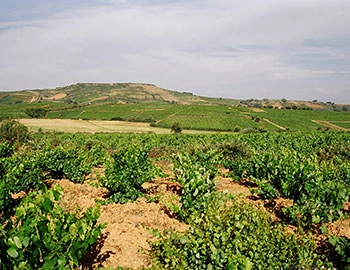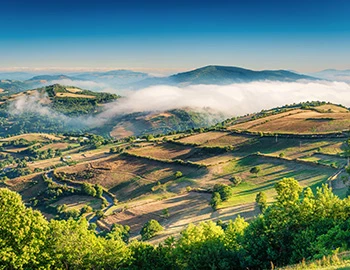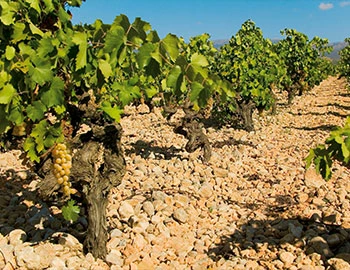Castro Ventosa Valtuille 2021
DO Bierzo, Castro Ventosa, 750 ml

| Grape variety: | Mencia, Alicante Bouschet |
| Producer: | Castro Ventosa / Fam. Pérez Pereira |
| Origin: | Spain / Galicia / Bierzo |
Description
Grown in a vineyard that is over 100 years old, influenced by continental and Atlantic-influenced climate, this elegant Spaniard pro vides much pleasure. The nose is invitingly fruity and floral, with aromas reminiscent of raspberries, strawberries and cherries, as well as roses and violets. On the palate it presents fresh and harmonious. The well-integrated acidity and the spicy-rustic touch unite with fine tannins and offer a great drinking flow. A perfect wine for everyday use, which goes well with meat and vegetable stews.
Attributes
| Origin: | Spain / Galicia / Bierzo |
| Grape variety: | Mencia, Alicante Bouschet |
| Label: | Vegan |
| Ripening potential: | 3 to 10 years |
| Drinking temperature: | 16 to 18 °C |
| Food Pairing: | Cold fish dish, dried meat, Hearty stew with pulses, Crispy roast chicken |
| Vinification: | soft pressing, fermentation in steel tank |
| Harvest: | hand-picking, strict selection |
| Maturation: | in used barriques |
| Maturation duration: | 12 months |
| Volume: | 13.0 % |
| Note: | Contains sulphites |
Castro Ventosa / Fam. Pérez Pereira
Castro Ventosa - a bodega in the heart of the Bierzo vineyards. The DO Bierzo, in northwestern Spain, covers about 3500 hectares of vineyards, 70 % of which are between 40 to over 100 years old. On limestone soils interspersed with sand, the indigenous grape variety Mencía feels particularly at home here
In 1752, a member of the Pérez Pereira family acquired 54 hectares of land in Valtuille de Abajo. Today, the family has been growing wine here for four generations. The most famous winemaker in the region is probably Alvaro Palacios, although his family winery Palacios Remondo is in Rioja. Alvaro came to the region as a flying winemaker for the Castro Ventosa winery, where he learned how to work with Mencía before founding his own bodega, thus making the Bierzo region known throughout the world.Thanks not least to the know-how of Alvaro Palacios and the ambition and experience of the Pérez Pereira family, the two wines El Valtuille and El Castro del Valtuille are now among the best wines made from the Mencía grape.

Castro Ventosa / Fam. Pérez Pereira
Castro Ventosa - a bodega in the heart of the Bierzo vineyards. The DO Bierzo, in northwestern Spain, covers about 3500 hectares of vineyards, 70 % of which are between 40 to over 100 years old. On limestone soils interspersed with sand, the indigenous grape variety Mencía feels particularly at home here
In 1752, a member of the Pérez Pereira family acquired 54 hectares of land in Valtuille de Abajo. Today, the family has been growing wine here for four generations. The most famous winemaker in the region is probably Alvaro Palacios, although his family winery Palacios Remondo is in Rioja. Alvaro came to the region as a flying winemaker for the Castro Ventosa winery, where he learned how to work with Mencía before founding his own bodega, thus making the Bierzo region known throughout the world.Thanks not least to the know-how of Alvaro Palacios and the ambition and experience of the Pérez Pereira family, the two wines El Valtuille and El Castro del Valtuille are now among the best wines made from the Mencía grape.

Alicante Bouschet
Concise in colour and flavour
The trademark of the Alicante Bouschet is its rich, dark colour. Like the Cinsault or Regent, it is one of the teinturier varieties. These are grapes with red flesh and red juice – for all other varieties, the pigments rest in the skin. The Alicante Bouschet was cultivated in Languedoc by Henri Bouschet in 1855. It is called “Alicante” because one of the hybrid partners was the Garnacha grape, which is traditionally referred to as Alicante in Spain. The Alicante Bouschet is found around the Mediterranean. The largest vineyards lie on Spain's Levante coast. In addition, it thrives in the Portugese Alentejo. It yields dark, robust, mellow wine with deep fruit.

Bierzo
Bierzo: to the top with the Mencia variety
At the beginning of the 90s, the Bierzo region, which is crossed by the Camino de Santiago, was barely known in the international wine scene. It was only when new residents and investors began to bottles top crus from selected slopes, which perfectly united finesse and force, that interest in this region and its primary variety grew. This variety, Mencia, is considered one of the highest quality red wine varieties in the Iberian Peninsula.

Galicia
Galicia: shaped by the cool Atlantic
Situated in the far northwest of the Iberian Peninsula, Galicia is like a tip which pushes west toward the Atlantic Ocean, north of Portugal. In keeping with this exposed location, wines made here, with their fresh, straightforward character, depart strikingly from the general style of Spanish wines. With four cultivation areas with DO status, Galicia is drawing noticeably more international interest. White wines from autochthonous varieties are mostly produced here.

Spain
Spain – Variety and perfection
“Somewhere in la Mancha, in a place whose name I do not care to remember...,” begins Don Quixote's odyssey.
The most famous part is definitely when Don Quixote thinks windmills are his enemy and wants to fight them – until they nearly kill him. It’s possible there was a bit too much of the La Mancha wine at play. Spanish vines fight for their survival in rugged landscapes, battling fierce drought and rough soils. But they fight well.



